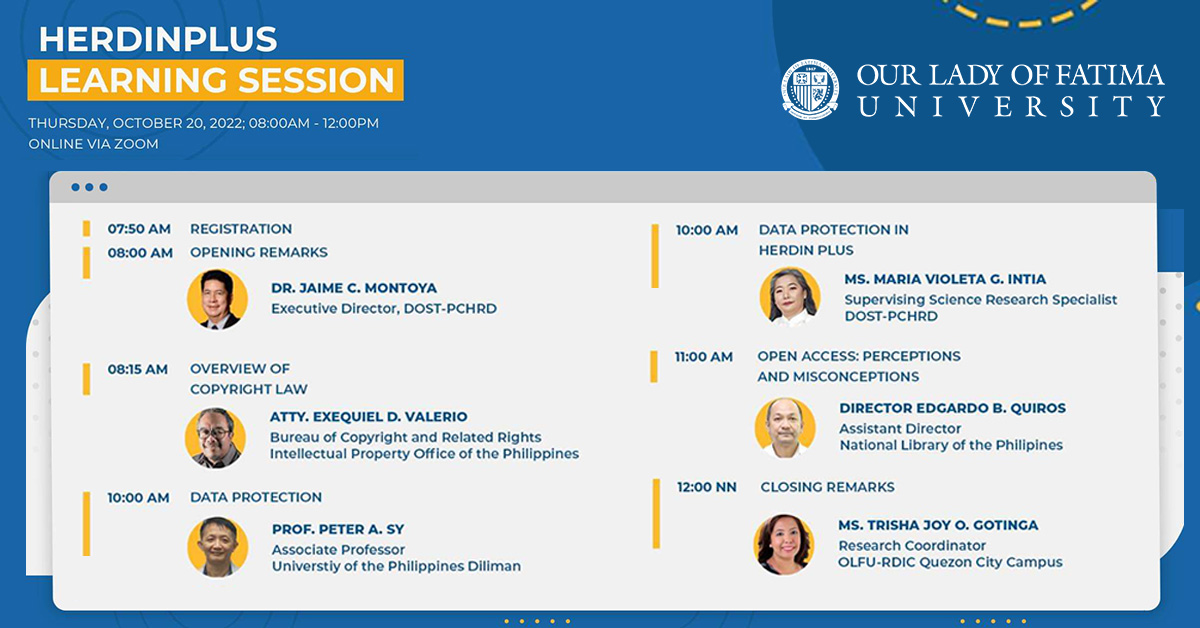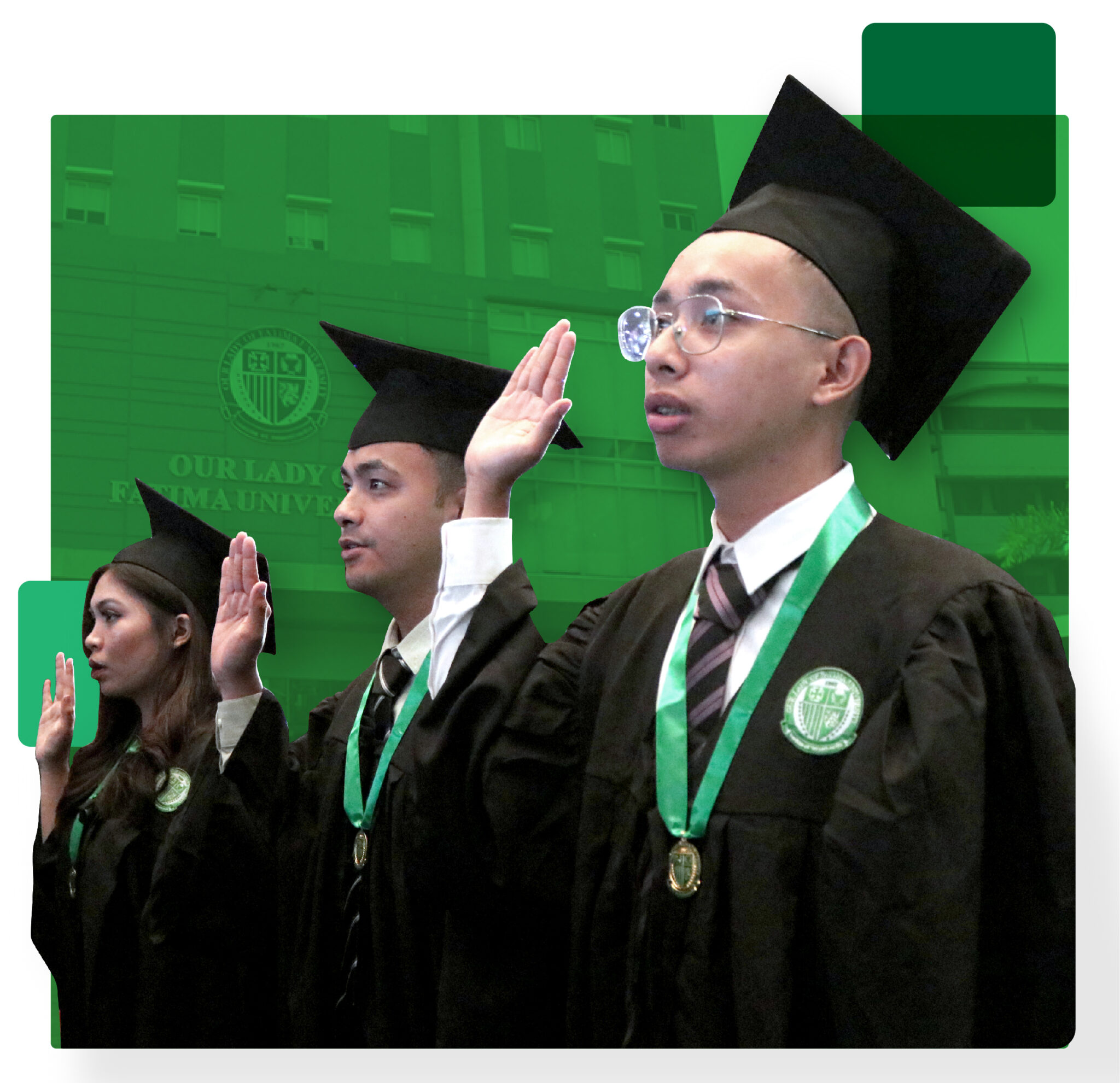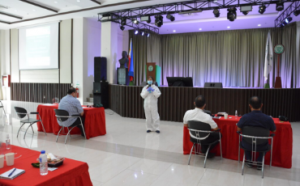On 20 October 2022, the Department of Science and Technology’s Philippine Council for Health Research and Development (DOST-PCHRD) ran its self-conceived training webinar, HERDIN PLUS Learning Session, for the academic leaders of Our Lady of Fatima University (OLFU).
Originating back in 1986, the HERDIN or Health Research and Development Information Network, is a brainchild of the DOST-PCHRD aimed at creating a smooth flow and exchange of health-related knowledge in the Philippines. In relation, HERDIN PLUS is an information and collaboration online platform for higher education and research development institutions. Part and parcel of their mission is to expand the reach of learning through its series of webinars. OLFU partnered with the DOST-PCHRD to infuse the former’s stakeholders with the basics on the matter of copyrighting and data protection.
The special session opened with Dr. Jaime C. Montoya, DOST-PCHRD Executive Director, who laid down the value of copyrighting and gave a preamble on the topics for discussion.
First speaker in line was Atty. Exequiel D. Valerio from the Bureau of Copyright and Related Rights of the Intellectual Property Office of the Philippines. In covering an overview of the concept of copyrighting, Atty. Valerio introduced an abundance of topics like: who are and are not protected by copyright; special rules on copyright ownership, including those exceptions covered by the so-called Technology Transfer Act; the economic and moral rights of a copyright owner; the definition of copyright infringement; the concept of fair use, and the benefits of registering and depositing one’s copyrighted works.
Next, Prof. Peter Sy, discussed the significance of data protection. An Associate Professor with the University of the Philippines Diliman, Prof. Sy dissected the component of privacy protection and information security, and its shared characteristics of availability and resilience of data, the level of confidentiality, and integrity which all, in turn, impact on the security of processing data. Then, he referenced the DOST Data Privacy Toolkit which helps researchers when conducting studies using human respondents. Prof. Sy advised that, before agreeing to share one’s personal data, one should lead with questions using “what”, “who”, “why”, “how”, and “how long”. Further, he presented an algorithm in undertaking a privacy impact assessment, as well as the import of principle of transparency whereby people have the right to learn about privacy policies and practices, and that they have the right to know how their personal information is shared.
Before doing any research, Prof. Sy said it is critical to lay down ground rules in how data is to be handled. How long data can be kept, who should have access, collection/ modification/ disclosure are a few things to look out for. Prof. Sy then went ahead to present the points of creating and implementing a data management plan.
Taking the virtual centerstage next was Maria Violeta Intia, DOST-PCHRD Supervising Science Research Specialist, who tackled Data Protection and Management in HERDIN PLUS. She took viewers through the process of creating an account in HERDIN PLUS and uploading data in the system— discussing the details on data collection, use, storage, and transfer.
The last speaker for the HERDIN PLUS Learning Session spoke about the concept of Open Access. He was Director Edgardo B. Quiros, Assistant Director of the National Library of the Philippines who began by defining “open access” as it is essayed in the 2003 Berlin Declaration on Open Access to Knowledge in the Sciences and Humanities. Here, open access is defined as “universally and freely accessible, at no cost to the reader, via the Internet or otherwise.” Still citing one of the stipulations of the same document, Director Quiros said that, in open access resources, the author or copyright owner grant users, “for an unlimited period, the right to use, copy, or distribute the article, on condition that proper attribution is given.” He adds that for a document to be considered as “open access”, it must reside in storage that is globally- and widely known as one that is dedicated to “open access”.
Essaying the positives, Director Quiros stated that open access helps enrich scholarly literature, readership, citations, professional recognition, and academic rankings, among others. As to the negatives, plagiarism and disputes on authorship/ownership could come into play, he said.
For institutions like OLFU, Director Quiros continued by prescribing a guide on how “open access” could be put into play beginning with setting up an Intellectual Property Office and creating guidelines around an “open access policy”. He named different business models of open access such as subscriptions, advertisements, donations, crowd-sourcing, and more.
For existing working models, Director Quiros introduced the Global Open Access Portal (GOAP), the Directory of Open Access Journal (DOAJ), the Networked Digital Library of Theses and Dissertations (NDLTD), the Philippine National Bibliography, the US National Library of Medicine, and the World Health Organization (WHO): Institutional Repository for Information Sharing, to name a few.
Ending his talk, Director Quiros outlined the challenges of open access documents. Language, typescript, internet bandwidth, computer hardware, embargo, pre-print, and archiving are some of these hurdles.


